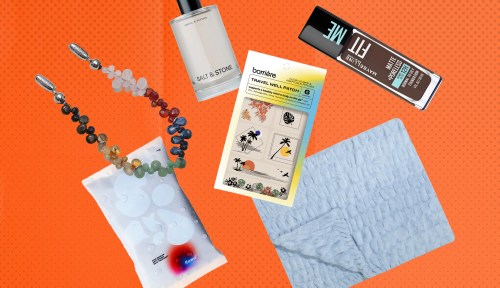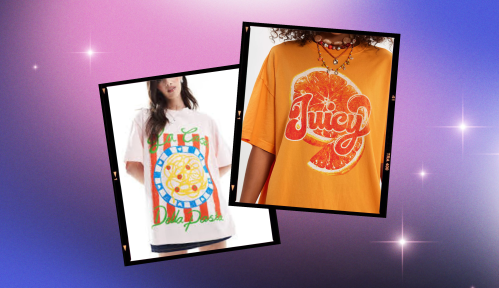Clothes Made of Recycled Water Bottles Are Everywhere—But Are They Sustainable?
So many brands are creating lines of clothes made from recycled plastic water bottles. How sustainable are they really?

It’s now as easy to wear a plastic water bottle as to drink out of one. Whether in the form of a swimsuit from Target, a puffer jacket from Madewell or leggings from Girlfriend Collective, recycled plastic water bottles have become the material that makes up much of our clothing.
If it feels like this phenomenon burst out of nowhere, that’s because it’s grown with incredible speed in a very short period of time. According to Melissa Henkle, director of brand sales at Unifi, a leading manufacturer of fabrics made from plastic bottles, it took the company a decade to recycle ten billion bottles leading up to 2017. But it took only two and a half years after that to recycle the next ten billion bottles, illustrating how massively production and demand for the material has grown.
The appeal for brands to use recycled plastic water bottles to make their gear is simple: recycling, they say, is a more earth-friendly alternative. And though bottles aren’t the only form of plastic being recycled into clothing (old fishing nets are another common contender) they are one of the most popular.
But is this seemingly ubiquitous material really the sustainability solution it’s cracked up to be?
In answering that question, it helps to zoom out a bit to look at the fashion industry as a whole. When plastic water bottles are turned into fabric, the result is polyester, aka the most commonly used textile fiber in the world. According to a report from Textile Exchange, polyester made up about 52 percent of fibers produced globally in 2019, and only 14 percent of that total was made from recycled materials.
“Using recycled plastic bottles is an improvement against using virgin polyester materials,” says Textile Exchange director of standards Ashley Gill. It’s not hard to see why. Both polyester and plastic bottles are derived from climate change-causing fossil fuels, so reducing demand for virgin materials is an obvious boon.
Even when it is recycled, polyester still poses environmental questions.
But even when it is recycled, polyester still poses environmental questions. Some of the biggest concerns with its use in recent years have come from emerging research about microplastics, which are tiny particles shed from synthetic textiles like polyester every time they’re washed or worn. These miniscule pieces of plastic are increasingly finding their way into human food, air, and water sources.
Though the potential ramifications for human and ecosystem health are still being researched, early studies don’t look good. There’s reason to believe microplastic pollution can harm ocean ecosystems and damage human lungs. To Francesca de Falco, a post-doctoral research fellow at the University of Plymouth who’s authored numerous studies on microplastics, that’s reason enough to try and curb microfiber pollution immediately.
“Because they are plastic particles in the environment, they are not going to disappear,” she explains. “The concentration will become greater year after year, and we will reach a critical point where we will have consequences but will not be able to do anything to stop them.”
Cult favorite athleisure label Girlfriend Collective, which makes about 80 percent of its clothing from recycled polyester derived from plastic bottles, admits that microplastics are a problem. Like fellow sustainability-centric brands Reformation and Patagonia, it even sells a microfiber filter on its website, which is meant to catch the microplastics coming out of your washing machine before they end up in the ocean. But according to De Falco, the problem is far too big for this solution to suffice on its own.
“Fibers can be released when you wear clothes, when you wash clothes, during their manufacturing and so on,” she says. “So you have to act at all these different levels.”
Microplastic pollution isn’t the only thing that casts a shadow on the environmental claims of polyester made from recycled plastic bottles. There’s also the complicated problem of recycling logistics. Plastic bottles get recycled so often in part, says Gill, because there are strong systems in place for bottle collection. If old bottles aren’t turned into clothing, they could be turned into new bottles which could then be recycled again at the end of their useful life. With clothing, though, end-of-life-collection systems are not nearly as robust, which means that old garments are much less likely to be recycled into new ones. “If you think about it on a system level, it is probably the case that by moving a bottle into the fiber supply chain, you’re decreasing the chance that that’s going to be recycled again,” she says.
That problem is further compounded by the fact that recycled polyester is often blended with other materials like cotton, which makes it even harder to separate out and recycle again in the future. Brands like Girlfriend Collective and companies like Unifi are trying to work toward more textile-to-textile recycling, but it’s still more of a future proposition than a currently scalable reality.
Fabrics made from recycled plastic bottles are far from a sustainability silver bullet.
In short: fabrics made from recycled plastic bottles are far from a sustainability silver bullet.
But that’s partly true simply because no fabric is a sustainability silver bullet. Microplastics may take a frighteningly long time to decompose, but even natural fibers like cotton can shed microfibers. Considering the heavy chemicals and toxic dyes that so much clothing is treated with, those natural microfibers may cause problems too, even if they don’t last as long as their synthetic counterparts.
Plus, part of the move toward a more sustainable fashion industry involves producing and buying fewer pieces, but expecting them to last a long time — which means there might be certain kinds of apparel, like performance sportswear, that really do make sense to manufacture from synthetic materials if that’s the best way to make them durable.
All in all, less polyester would be best for the earth. But if it’s going to be used, better that it be made from recycled materials than not. And even within that category, Gill hopes that companies and citizens alike will push for constant improvement — and refuse to treat recycled materials as a pass for excessive production and consumption.
“There’s no such thing as a fiber that has solved all of its problems,” she says. “Sometimes when we communicate that this is a preferred material, that gets taken to mean ‘it’s good enough the way it is.’ And I don’t think you can say that about any material — certainly not recycled polyester.”
Oh hi! You look like someone who loves free workouts, discounts for cult-fave wellness brands, and exclusive Well+Good content. Sign up for Well+, our online community of wellness insiders, and unlock your rewards instantly.
Sign up for the Well+Good SHOP Newsletter
Get exclusive deals on wellness, beauty, fitness, and food products that have been hand-picked by our editors.
Got it, you've been added to our email list.










